

This group of artists is named for eight panels (1473) that depict miracles of St Bernardino of Siena, which are dated by inscription (above the arch of Titus in the panel on the bottom left below): they were first recorded in 1784 in the sacristy of San Francesco al Prato (link below) and are now in the Galleria Nazionale:

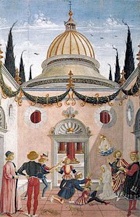
St Bernardino restores to life St Bernardino heals Giovanni
a man found dead under a tree Antonio da Parma, who has been
wounded by a nail in his head
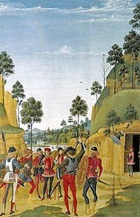
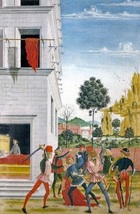
St Bernardino posthumously St Bernardino posthumously heals the
liberates a man who has been wounds of Giovanni Antonio Tornano,
unjustly imprisoned who has been hurt in an ambush
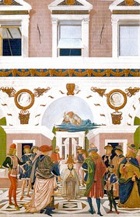
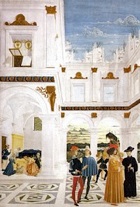
St Bernardino posthumously ** St Bernardino restores to life
restores the sight of a blind boy a baby that has died at birth
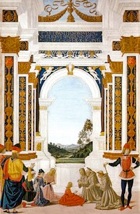
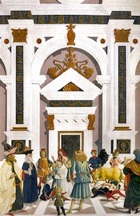
St Bernardino cures the daughter of ** St Bernardino revives Nicolò di
Giovanni Antonio Petrazio da Rieti Lorenzo da Prato, who has been
of an ulcer trampled by a bull
History of the Panels
As noted above, these panels were first recorded in 1784 in the sacristy of San Francesco al Prato. They were said to have been “sawed” from a niche that had housed a statue of St Bernardino.
The panels were removed from Perugia after the Napoleonic suppression 0f 1810:
-
✴Dominique-Vivant Denon, the Director of the Musée Napoleon (later the Musée du Louvre) selected two of them (marked ** above) for confiscation in 1812, and they were duly shipped to Paris. Antonio Canova recovered them in 1815.
-
✴Agostino Tofanelli, the Director of the Musei Capitolini, took the other six to Rome.
They were all returned to San Francesco al Prato in 1817, and transferred to the Galleria Nazionale in 1863, together with a panel depicting the trigram “IHS” which came from the top of the niche.
The panels were restored in 1991-3, and it was during this work that it was confirmed that they had originally been painted on two planks (four scenes on each) that decorated the vertical sides of a niche. Technical analysis has allowed the original order of the panels to be established, as set out above.
Provenance and Attribution
These panels are among the earliest surviving works in Perugia that fully reflect the aesthetic of Renaissance Florence and of the courts at Urbino and Rimini, and it is surprising that they went unrecorded for so long. They were almost certainly commissioned in response to the translation of the relics of St Bernardino to the new church of the Observant Franciscans in Aquila in 1472. The scenes depicted were derived from the “Lo Specchio de l’ Ordine Minore” (otherwise known as “La Franceschina”), which was published by the Observant Franciscan Giacomo Oddi of Perugia in ca. 1474.
Candidates for the original location of the niche in which the panels were mounted include:
-
✴the Oratorio di San Bernardino; and
-
✴the Cappella di San Bernardino (now the Cappella del Santo Anello) in the Duomo.
At the time that the panels were first recorded, they were attributed to Pisanello (died 1455), and this attribution accompanied them when they were confiscated in the 19th century. This error was first noted at about the time that they were returned to Perugia.
It is generally agreed that the panels were conceived as part of a coherent program by a single designer, but that a number of individual artists were involved in their execution. The identities proposed for these artists have varied over time. Recent scholarship, as summarised in the reference below, suggests that the designer was most probably Bartolomeo Caporali:
-
✴the attribution of the top two panels on the right to Pierantonio di Nicolò del Pocciolo is made on the basis of miniatures (1472) in an antiphonary from the Abbazia di San Pietro that are securely his work (see Schedules 7 and 8 in the catalogue referenced below).
-
✴the bottom two panels on the right (marked **) attributed to Sante di Apollonio; and
-
✴the young Pintoricchio is generally held to have contributed to the panels on the left, along with Perugino and/or Fiorenzo di Lorenzo.
Read more:
P. Mercurelli Salari, Schedule 1, in:
V. Garibaldi and F. F. Mancini (Eds), “Pintoricchio” (2008), Milan
L. Teza, “Una Nuova Storia per le Tavolette di San Bernardino” in:
L. Teza and M. Santanicchia (Eds), “Pietro Vannucci detto il Perugino: Atti del Convegno Internazionale (Perugia–Città della Pieve, 25–28 October 2000)”, (2004), Perugia, pp 247-306
Return to: Art in Perugia Bartolomeo Caporali Fiorenzo di Lorenzo
Perugino Pintoricchio Sante di Apollonio
Return to Art in: Perugia.

